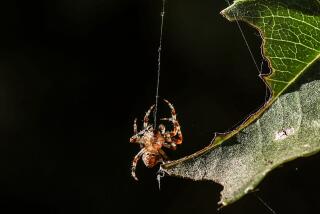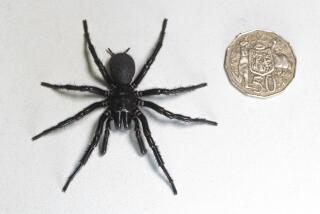Ancient, hidden spider discovered in caves of Pacific Northwest
- Share via
They managed to avoid the notice of nosy humans beings for thousands of years, mostly by clinging to the roofs of dark caves and keeping their six, tiny eyes peeled for trouble.
But the secret existence of these eight-legged West Coasters has come to an end.
On Friday, scientists announced the discovery of a heretofore unknown family of spider that some have playfully compared to Bigfoot, the privacy-loving man-beast of legend.
In the journal Zookeys, California Academy of Sciences arachnologist Charles E. Griswold and colleagues described their discovery of trogloraptor, or “cave robber,” a spider that is partial to caves and redwood debris in coastal forests from California to British Columbia.
Trogloraptor, which is roughly the size of a half-dollar coin when its legs are extended, has large raptorial claws, suggesting it is a fierce, specialized predator.
Roughly a dozen specimens were plucked from the roofs of caves by scientists and spelunkers who found them hanging from a few strands of spun silk. Most were obtained in southwest Oregon, while one adolescent spider was found in the debris of old-growth redwoods in northwest California.
The newly discovered arachnid is not about to give up all its long-held secrets, however. Scientists have yet to determine exactly how it mates, or what it eats. Captive trogloraptors have so far refused to eat a variety of prey provided in the lab.
The Klamath-Siskiyou region of Oregon and California is home to a number of ancient species of plants and animals, including the coastal red tailed frog and the mountain beaver. Study authors note that with many caves and hard-to-access areas, this may not be the last historic find.
“If such a large and bizarre spider could have gone undetected for so long, who knows what else may lurk undiscovered in this remarkable part of the world,” the study said.
By examining the spider under an electron microscope, etymologists found a number of unique features that suggested a very ancient lineage. The discovery may yet result in some revisions to their understanding of spider evolution.
Among those groups who helped to collect the specimens were the Western Cave Conservancy, the California Academy of Sciences and San Diego State University.
Follow me on Twitter @montemorin







